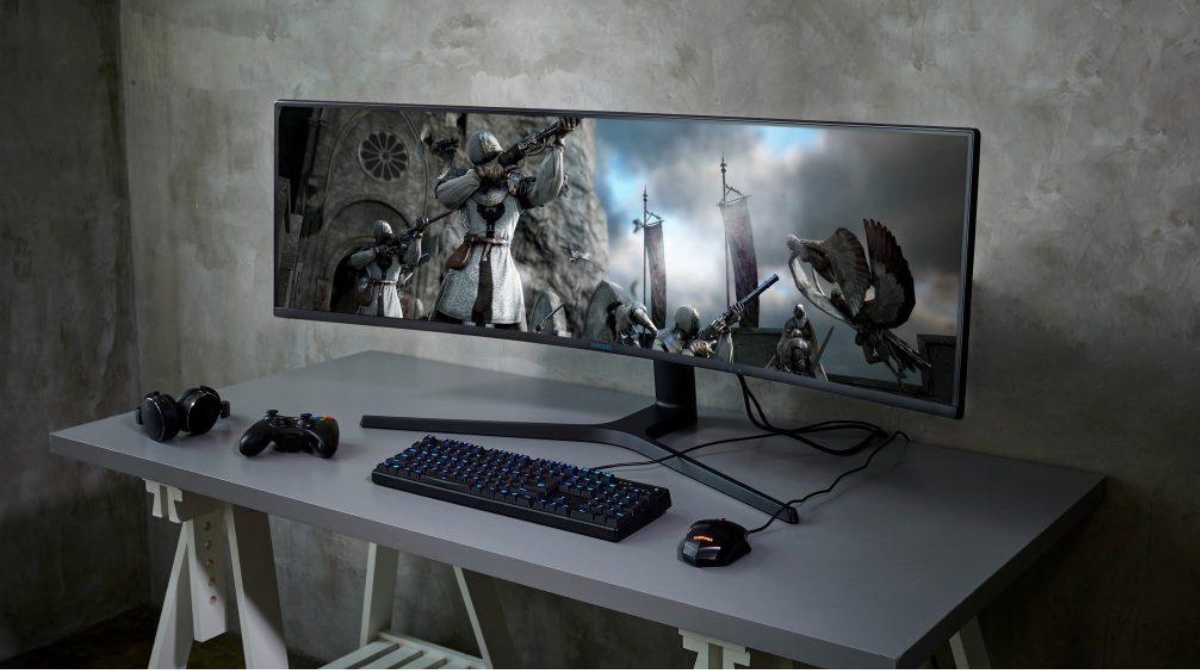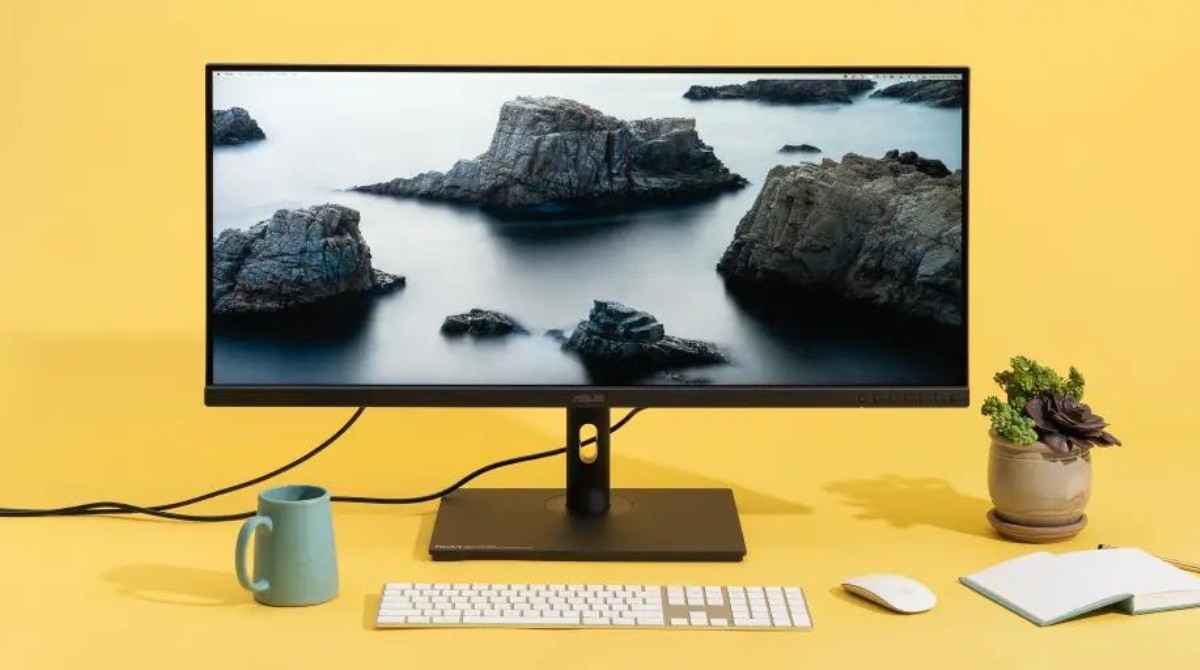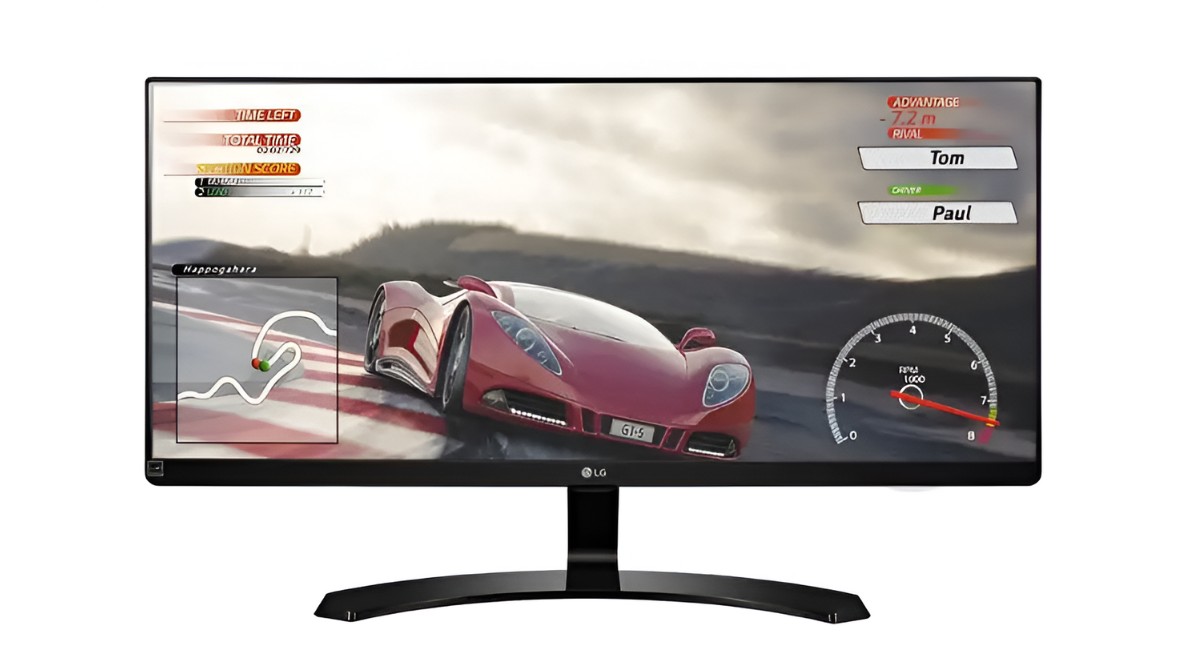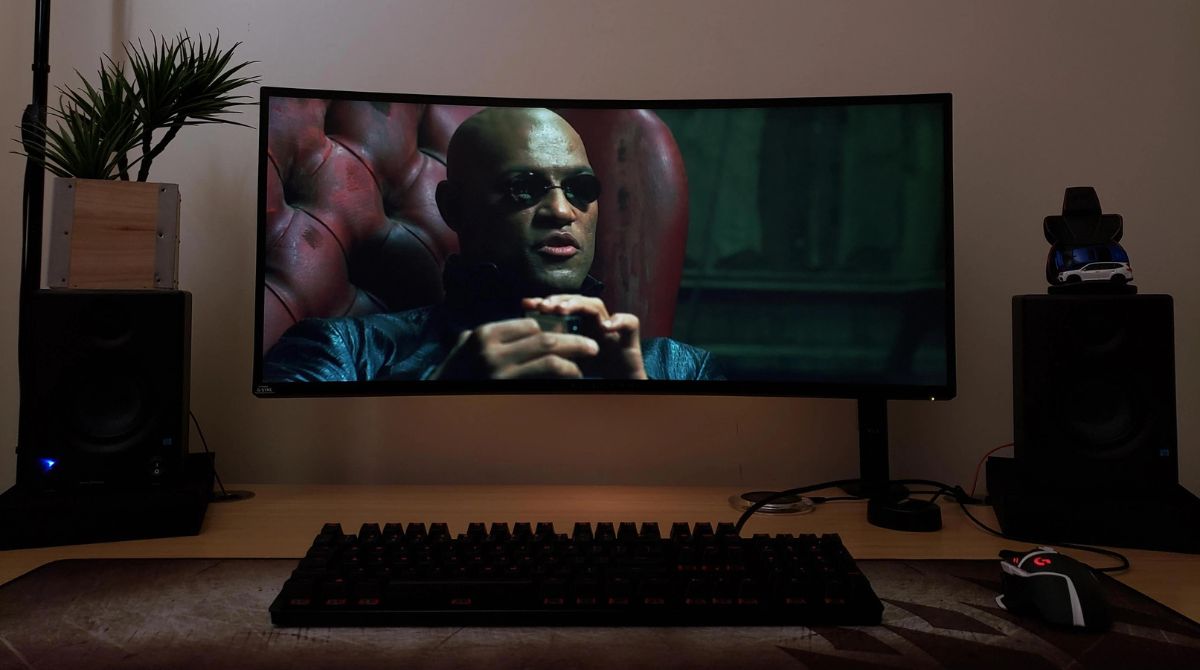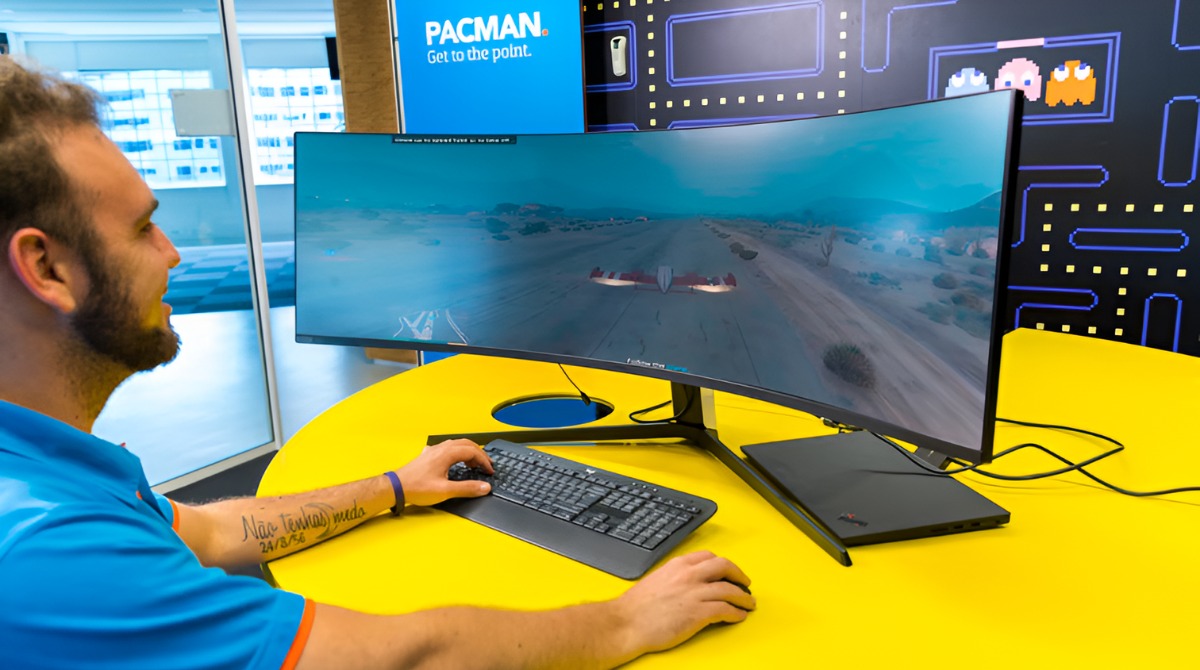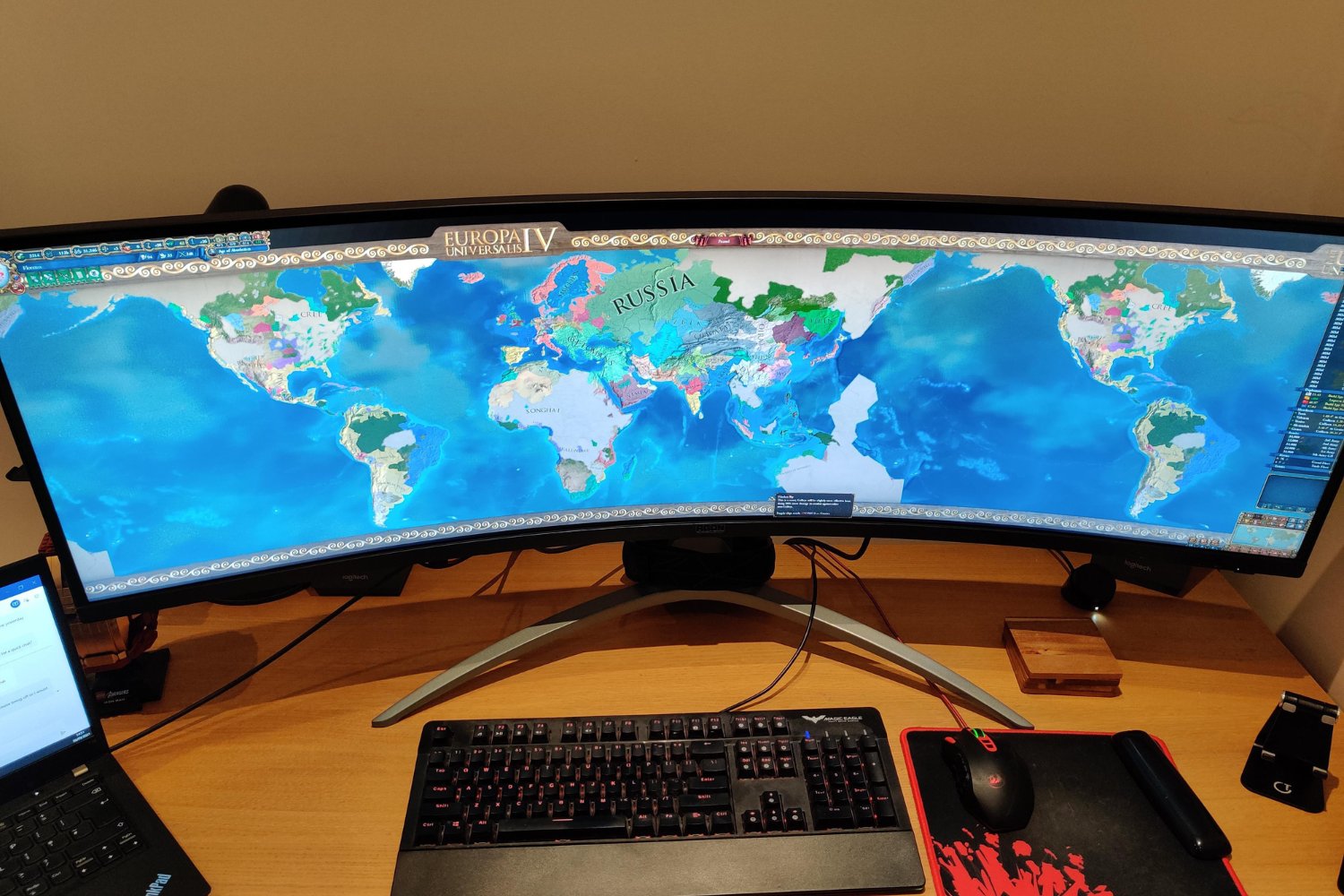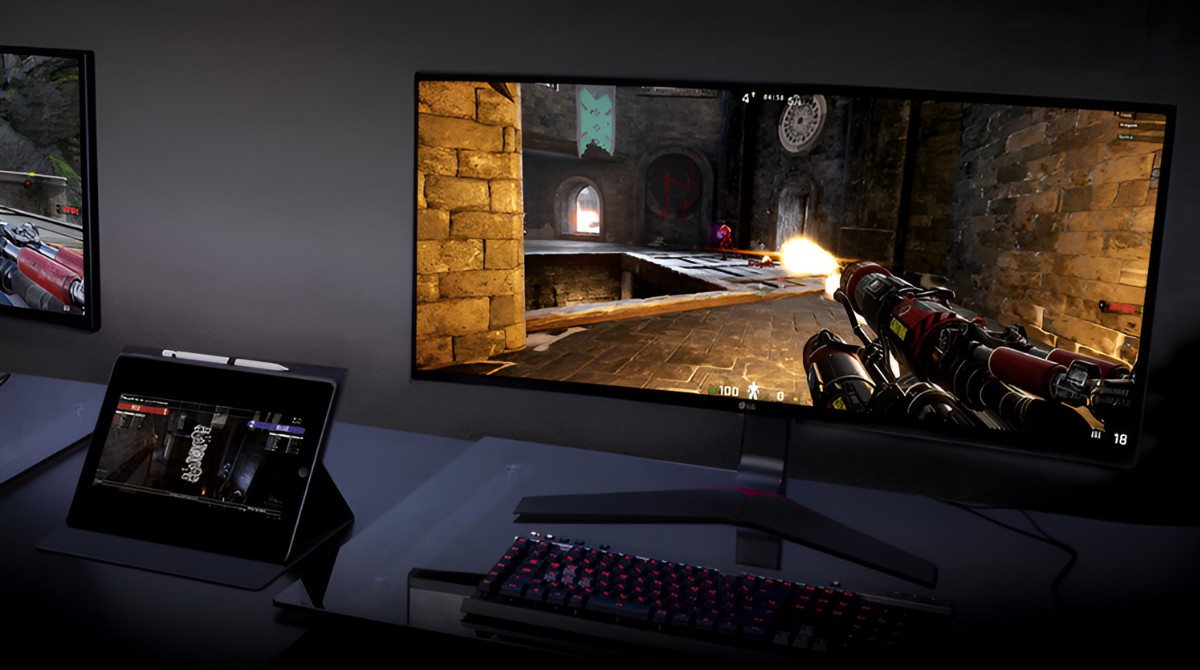Introduction
Welcome to the world of ultrawide monitors! If you’re looking to elevate your multimedia experience, increase your productivity, or immerse yourself in gaming, an ultrawide monitor is the perfect choice. With their wider aspect ratios, these monitors provide a larger viewing area, giving you more screen real estate for multitasking, cinematic experiences, and seamless gaming action. But before you dive into the world of ultrawide monitors, it’s essential to understand the graphics card requirements to fully optimize your display’s potential.
Ultrawide monitors have become increasingly popular due to their ability to enhance productivity and entertainment. Unlike traditional monitors with a 16:9 aspect ratio, ultrawide monitors boast a wider aspect ratio, typically 21:9, creating a more immersive visual experience. This additional screen space allows you to have multiple windows open side-by-side, making it easier to work on complex tasks or view multiple documents simultaneously.
When it comes to gaming, ultrawide monitors offer a panoramic view that provides a more immersive gaming experience. With the wider display, you’ll have a broader field of vision, allowing for greater spatial awareness in games. Whether you’re exploring vast open worlds or engaging in intense multiplayer battles, an ultrawide monitor can take your gaming to the next level.
However, in order to fully capitalize on the benefits of an ultrawide monitor, you need to ensure your graphics card can support the high resolution and demands of these displays. Graphics cards are responsible for rendering and delivering the images and graphics to your monitor, so having a suitable one is vital to experience smooth performance and stunning visuals.
In the following sections, we will cover different aspects of choosing the right graphics card for your ultrawide monitor. We’ll discuss the significance of resolution, consider gaming requirements, compare AMD and NVIDIA options, and highlight important factors to keep in mind when making your purchase. So, let’s dive in and explore the world of ultrawide monitors and the graphics card requirements necessary to maximize their potential.
Understanding Ultrawide Monitors
Ultrawide monitors are a game-changer in the world of displays. Unlike traditional monitors with a 16:9 aspect ratio, ultrawide monitors feature a wider aspect ratio of typically 21:9. This wider screen real estate offers a variety of benefits for both work and play.
One of the biggest advantages of an ultrawide monitor is the increased screen space it provides. The additional width allows for more windows and applications to be open side-by-side, making multitasking a breeze. Whether you’re a content creator juggling multiple editing software or a professional working on spreadsheets and presentations, an ultrawide monitor allows you to see more of your work at once, boosting productivity.
Moreover, ultrawide monitors are perfect for multimedia consumption. The wider aspect ratio creates a more immersive experience while watching movies or videos. You can enjoy cinematic content without the black bars at the top and bottom of the screen, as ultrawide monitors align more closely with the aspect ratio of movies. The wider field of view engulfs you in the action, providing a truly immersive entertainment experience.
For gamers, ultrawide monitors offer a competitive edge. With the wider screen, you can see more of the game world, giving you a wider field of view and enhancing your situational awareness. Whether you’re playing action-packed first-person shooters or exploring vast open-world games, the ultrawide aspect ratio adds an extra layer of immersion, making every gaming session more exciting and captivating.
It is worth noting that while ultrawide monitors offer a broad viewing area, they do have a lower vertical resolution compared to standard 16:9 monitors. For example, a typical 34-inch ultrawide monitor has a resolution of 3440×1440 pixels, which is equivalent to a QHD resolution. However, there are also ultrawide monitors available with even higher resolutions, such as 3840×1600 (WQHD+) or 5120×2160 (5K), for those seeking an even more pixel-dense display.
Understanding the unique features and advantages of ultrawide monitors is crucial when making decisions about the graphics card you will pair with your monitor. With the right graphics card, you can fully tap into the immersive potential and ensure smooth performance on your ultrawide display.
Choosing the Right Resolution for Your Needs
When it comes to ultrawide monitors, one important factor to consider is the resolution. The resolution of a monitor determines the number of pixels it can display, which directly affects the clarity and sharpness of the visuals. Different resolutions offer different levels of detail and pixel density, so it’s essential to choose the right resolution that suits your needs.
The most common resolution for ultrawide monitors is 3440×1440 pixels, also known as QHD or 1440p. This resolution strikes a balance between providing a high level of detail and maintaining smooth performance in games and multimedia applications. It offers a clear and sharp image on the larger display, making it a popular choice for both productivity and gaming purposes.
If you’re looking for an even more immersive experience or require a higher level of detail, you can consider ultrawide monitors with resolutions beyond 3440×1440 pixels. For example, there are ultrawide monitors available with resolutions of 3840×1600 pixels, also known as WQHD+, or even 5120×2160 pixels, known as 5K. These higher resolutions provide incredibly sharp visuals and allow for even more screen real estate for multitasking or enjoying stunning cinematic content.
However, it’s worth noting that higher resolutions require more powerful hardware, especially graphics cards, to render the visuals smoothly. If you opt for a higher resolution ultrawide monitor, make sure your graphics card can handle the increased demand. Otherwise, you may experience lower frame rates, stuttering, or overall performance issues.
On the other hand, if you primarily use your ultrawide monitor for productivity tasks and don’t require a high level of detail, a lower resolution option may suffice. For basic office work or web browsing, a 2560×1080 pixel resolution, also known as WFHD, can provide a satisfactory experience.
Ultimately, choosing the right resolution for your ultrawide monitor comes down to your specific needs and budget. Consider factors such as the type of content you mainly consume or create, the level of detail you desire, and the capabilities of your current hardware. Make sure to strike a balance between visuals, performance, and affordability to ensure a satisfying overall experience with your ultrawide monitor.
Considerations for Gaming on an Ultrawide Monitor
Gaming on an ultrawide monitor offers a whole new level of immersion and gameplay experience. The wider aspect ratio provides a broader field of view, allowing you to see more of the game world and enhancing your gaming performance. However, there are several considerations to keep in mind when gaming on an ultrawide monitor to ensure the best experience possible.
The first consideration is game compatibility. While many modern games support ultrawide resolutions out of the box, some older or less popular titles may not. In such cases, you may need to use third-party software or modifications to enable ultrawide support. It’s a good idea to check the game’s compatibility or consult online forums to ensure that your favorite games are compatible with ultrawide resolutions before making a purchase.
Another important aspect to consider is the aspect ratio of the game itself. Most games are designed for the standard 16:9 aspect ratio, so when played on an ultrawide monitor, they may have black bars on the sides of the screen, resulting in a “letterbox” effect. Some games, known as “ultrawide-friendly” or “ultrawide-supported” games, are optimized for the wider aspect ratio, filling the entire screen without any black bars. These games provide a truly immersive experience on an ultrawide monitor, taking full advantage of the expanded field of view.
Graphics settings are also crucial for optimal gaming on an ultrawide monitor. The higher resolution of ultrawide displays can put a strain on your graphics card. To maintain smooth performance, it’s important to adjust the graphics settings accordingly. You may need to lower some settings such as anti-aliasing or shadow quality to achieve a balance between visual fidelity and smooth gameplay. Experimenting with different settings will help you find the right balance for each game.
One potential drawback of gaming on an ultrawide monitor is the increased demand on your hardware, specifically the graphics card. Ultrawide resolutions require more graphical horsepower compared to standard 16:9 resolutions. Therefore, it’s important to have a graphics card that can handle the increased workload to ensure smooth frame rates and an enjoyable gaming experience. Consider researching and investing in a high-performance graphics card that is capable of handling the demands of ultrawide gaming.
Lastly, keep in mind that games with a fixed user interface (UI), such as HUD elements or menus, may have their placements affected by the wider aspect ratio. Some games may stretch or reposition UI elements, which can impact the overall user experience. Although this doesn’t necessarily hinder gameplay, it’s something to be aware of, especially if you value consistency in UI presentation.
Gaming on an ultrawide monitor can be a truly immersive and enjoyable experience. Consider the compatibility, aspect ratio, graphics settings, hardware requirements, and UI placement when gaming on an ultrawide monitor to maximize your gaming enjoyment and take full advantage of the widened field of view.
Graphics Card Requirements for Different Resolutions
When it comes to choosing a graphics card for your ultrawide monitor, it’s important to consider the resolution you will be using. Different resolutions require varying levels of graphical processing power to deliver smooth performance and visually stunning graphics.
For the most common ultrawide resolution of 3440×1440 pixels (QHD), a mid-range to high-end graphics card should be sufficient for smooth gaming and multimedia experiences. Graphics cards such as the NVIDIA GeForce GTX 1660 Super or the AMD Radeon RX 5700 offer excellent performance at this resolution, allowing you to play modern games with high settings and decent frame rates. If you’re a serious gamer or want to future-proof your system, an even more powerful card like the NVIDIA GeForce RTX 2060 Super or the AMD Radeon RX 5700 XT can provide even better performance and ray-tracing capabilities.
For those seeking a higher resolution ultrawide experience, such as 3840×1600 pixels (WQHD+) or 5120×2160 pixels (5K), a high-end graphics card becomes even more necessary. Resolutions beyond QHD put a significant strain on the GPU, requiring more VRAM and processing power. Graphics cards like the NVIDIA GeForce RTX 3080 or the AMD Radeon RX 6800 XT are designed for 4K gaming and can handle these higher resolutions with ease, delivering ultra-smooth frame rates and stunning visuals.
It’s important to note that besides resolution, other factors can impact the graphics card requirements, such as the refresh rate of your ultrawide monitor. If you have a high refresh rate monitor, such as 144Hz or 240Hz, you’ll need a more powerful graphics card to consistently achieve those higher frame rates. In this case, top-of-the-line graphics cards like the NVIDIA GeForce RTX 3090 or the AMD Radeon RX 6900 XT are recommended to fully utilize the monitor’s capabilities.
Additionally, when considering the graphics card requirements, keep in mind your intended usage. If you primarily use your ultrawide monitor for productivity tasks, such as video editing or 3D rendering, a professional-grade graphics card like the NVIDIA Quadro or AMD Radeon Pro series may be more suitable, as they are optimized for professional applications and provide better performance in those scenarios.
When selecting a graphics card for your ultrawide monitor, always check the system requirements of the specific games or software you plan to use. This will help ensure that the graphics card you choose meets the minimum and recommended specifications for the best performance and compatibility.
Ultimately, the graphics card requirements for different ultrawide resolutions vary depending on factors such as resolution, refresh rate, and intended usage. Consider your needs, budget, and desired level of performance to choose the right graphics card that can handle the demands of your ultrawide monitor and deliver an immersive and visually captivating experience.
AMD vs NVIDIA: Which Brand is Better for Ultrawide Monitors?
When it comes to graphics cards for ultrawide monitors, two major players dominate the market: AMD and NVIDIA. Both brands offer a wide range of options with varying performance levels and price points. So, which brand is better for ultrawide monitors? Let’s compare the two and see.
AMD’s Radeon graphics cards have gained popularity in recent years, thanks to their competitive pricing and impressive performance. AMD cards, such as the Radeon RX 5000 and Radeon RX 6000 series, offer excellent value for the money, delivering great gaming performance and high-quality visuals. AMD focuses on providing powerful hardware at an affordable price, making them a popular choice among budget-conscious gamers.
On the other hand, NVIDIA’s GeForce graphics cards have long been considered the gold standard in the industry. NVIDIA offers a wide range of options, from the more affordable GTX series to the high-end RTX series. NVIDIA’s RTX cards, such as the GeForce RTX 30 series, come equipped with features like ray tracing and DLSS (Deep Learning Super Sampling), providing visually stunning graphics and enhanced gaming experiences. These cards are known for their exceptional performance and power efficiency.
When it comes to driver support and software features, both AMD and NVIDIA have made significant strides in recent years. AMD’s drivers have improved significantly, which has resulted in smoother overall performance and better compatibility with various games. NVIDIA, on the other hand, has a long-standing reputation for its robust driver support and comprehensive software suite, including features like GeForce Experience for easy optimization and game-specific settings.
When deciding between AMD and NVIDIA for your ultrawide monitor, several factors come into play. If you’re on a tight budget or looking for solid gaming performance without breaking the bank, AMD’s Radeon cards offer excellent value for money. They provide reliable performance at a more affordable price point, making them a compelling choice for many gamers.
However, if you’re willing to invest a bit more for the best possible performance and cutting-edge features, NVIDIA’s GeForce cards may be the better option. NVIDIA’s RTX series of cards excel in ray tracing, providing realistic lighting and reflections in games that support the technology. Additionally, NVIDIA’s software suite provides robust features and a user-friendly experience.
Ultimately, the decision between AMD and NVIDIA for your ultrawide monitor comes down to your budget, specific requirements, and personal preferences. Consider factors such as pricing, performance, features, and software support to make an informed choice that suits your needs.
Factors to Consider When Buying a Graphics Card for an Ultrawide Monitor
Choosing the right graphics card for your ultrawide monitor is crucial to ensure optimal performance and an immersive visual experience. Here are some key factors to consider when purchasing a graphics card for your ultrawide monitor:
1. Resolution: The resolution of your ultrawide monitor will play a significant role in determining the graphics card you need. Higher resolutions, such as 3440×1440 (QHD) or 3840×1600 (WQHD+), require more processing power to deliver smooth performance and crisp visuals. Consider the resolution you plan to use and ensure that the graphics card you choose can handle it.
2. Refresh Rate: If your ultrawide monitor has a high refresh rate, such as 144Hz or 240Hz, you’ll need a graphics card that can consistently deliver high frame rates to take full advantage of the monitor’s capabilities. Look for a graphics card that can handle the demands of higher refresh rates to avoid screen tearing and maintain a smooth gaming experience.
3. Game Compatibility: Consider the games you play or plan to play on your ultrawide monitor. Some games may have specific requirements or compatibility issues with certain graphics card models. Check the system requirements of the games you’re interested in and ensure that the graphics card you choose meets or exceeds those requirements.
4. VRAM (Video Random Access Memory): The amount of VRAM on a graphics card is an important factor to consider, especially for higher resolution gaming. More VRAM allows for better texture quality and smoother rendering of complex scenes. Aim for a graphics card with ample VRAM to handle the demands of your chosen resolution and graphics settings.
5. Power Consumption: Different graphics cards have varying power requirements. Ensure that your power supply unit (PSU) can provide enough wattage to support the graphics card you choose. Additionally, consider the power efficiency of the graphics card for better energy consumption and heat management.
6. Budget: Your budget is a key factor in determining the graphics card you can afford. Set a budget and find the best card within that range that meets your performance needs. It’s important to strike a balance between performance and affordability to get the most value for your money.
7. Future-Proofing: If you want your graphics card to remain relevant for a longer period, consider future-proofing. Look for a card with more advanced features, such as support for ray tracing or DLSS, which can enhance your gaming experience and provide better compatibility with upcoming games.
8. Cooling and Form Factor: Consider the cooling mechanism of the graphics card, especially if you plan on overclocking or have limited airflow in your system. Look for graphics cards with efficient cooling solutions, such as multiple fans or custom cooling options. Additionally, check the physical dimensions of the graphics card to ensure it will fit comfortably within your PC case.
By considering these factors when buying a graphics card for your ultrawide monitor, you can make an informed decision that will provide you with the best performance, visuals, and overall gaming experience.
FAQs about Graphics Cards for Ultrawide Monitors
Here are some frequently asked questions about graphics cards for ultrawide monitors:
1. Can any graphics card support an ultrawide monitor?
Not all graphics cards are designed to support ultrawide monitors. It’s essential to check the specifications and compatibility of a graphics card before purchasing it for use with an ultrawide monitor.
2. What is the minimum graphics card requirement for gaming on an ultrawide monitor?
The minimum requirement for gaming on an ultrawide monitor typically depends on the specific resolution and settings you desire. For resolutions like 3440×1440, a mid-range graphics card like the NVIDIA GeForce GTX 1660 or AMD Radeon RX 5600 XT is often sufficient for decent gaming performance.
3. Do I need a higher-end graphics card for higher resolutions on an ultrawide monitor?
Higher resolutions on ultrawide monitors require more processing power. For resolutions like 3840×1600 or 5120×2160, it’s recommended to invest in a higher-end graphics card such as the NVIDIA GeForce RTX 3080 or AMD Radeon RX 6800 XT to ensure smooth gameplay and optimal visual quality.
4. Can I use multiple graphics cards for ultrawide gaming?
While it is technically possible to use multiple graphics cards for ultrawide gaming, it is not a common practice. Most games are not optimized for multi-GPU configurations, and you may encounter compatibility issues or diminishing returns in performance. A single powerful graphics card is usually the preferred choice for ultrawide gaming.
5. How important is VRAM for gaming on an ultrawide monitor?
VRAM (Video Random Access Memory) plays a significant role in handling high-resolution textures and rendering complex scenes. It is crucial to have a graphics card with a sufficient amount of VRAM for smooth gaming performance on an ultrawide monitor. Aim for at least 8GB or more for optimal visual quality.
6. Should I consider the brand of the graphics card when buying for an ultrawide monitor?
The brand of the graphics card, such as AMD or NVIDIA, should be considered based on factors such as pricing, performance, driver support, and specific features. Both brands offer quality options, so it’s important to research and compare their offerings to find the best fit for your needs and budget.
7. Do I need to upgrade my power supply for a high-end graphics card and ultrawide monitor?
High-end graphics cards, especially when paired with an ultrawide monitor, can have higher power requirements. It’s essential to check the power recommendations for the specific graphics card you plan to purchase and ensure your power supply unit (PSU) can provide enough wattage to support it.
8. How can I ensure compatibility between the graphics card and ultrawide monitor?
To ensure compatibility, check the connections and inputs/outputs of both the graphics card and the ultrawide monitor. Most modern graphics cards support DisplayPort, HDMI, or DVI outputs, while ultrawide monitors typically have DisplayPort or HDMI inputs. Ensure that the connections match and that the graphics card’s output supports the desired resolution of the ultrawide monitor.
By understanding these frequently asked questions, you can make informed decisions regarding the selection and purchasing of a graphics card for your ultrawide monitor, ultimately enhancing your gaming and multimedia experiences.
Conclusion
Choosing the right graphics card for your ultrawide monitor is crucial to unlocking its full potential and enjoying an immersive visual experience. By considering factors such as resolution, refresh rate, game compatibility, VRAM, power consumption, budget, future-proofing, cooling, and form factor, you can make an informed decision that meets your specific needs and requirements.
Whether you’re a gamer looking to immerse yourself in the vast worlds of your favorite games or a productivity enthusiast aiming to boost your multitasking capabilities, a well-matched graphics card is essential. It not only ensures smooth performance and stunning visuals but also enhances your overall enjoyment and productivity on the ultrawide monitor.
Both AMD and NVIDIA offer a wide range of options for graphics cards, each with their own strengths and capabilities. Consider factors such as pricing, performance, features, and software support to choose the brand that aligns with your priorities and budget.
Remember to take into account your specific ultrawide monitor’s resolution, refresh rate, and compatibility requirements. While mid-range graphics cards like the NVIDIA GeForce GTX 1660 Super or the AMD Radeon RX 5600 XT may be suitable for 3440×1440 resolution, higher resolutions like 3840×1600 or 5120×2160 may require more powerful cards such as the NVIDIA GeForce RTX 3080 or the AMD Radeon RX 6800 XT.
Take note of additional considerations like power consumption, VRAM, game compatibility, and cooling. Upgrading your power supply if necessary and ensuring sufficient VRAM can further optimize your gaming or productivity experience on an ultrawide monitor. Adequate cooling and checking the physical dimensions of the graphics card are also important for smooth and efficient operation within your PC case.
By carefully considering these factors and conducting research, you can confidently select the best graphics card for your ultrawide monitor. With the right graphics card in place, you can explore the vast possibilities of an ultrawide monitor and enjoy a captivating, immersive, and visually striking experience in both work and play.







